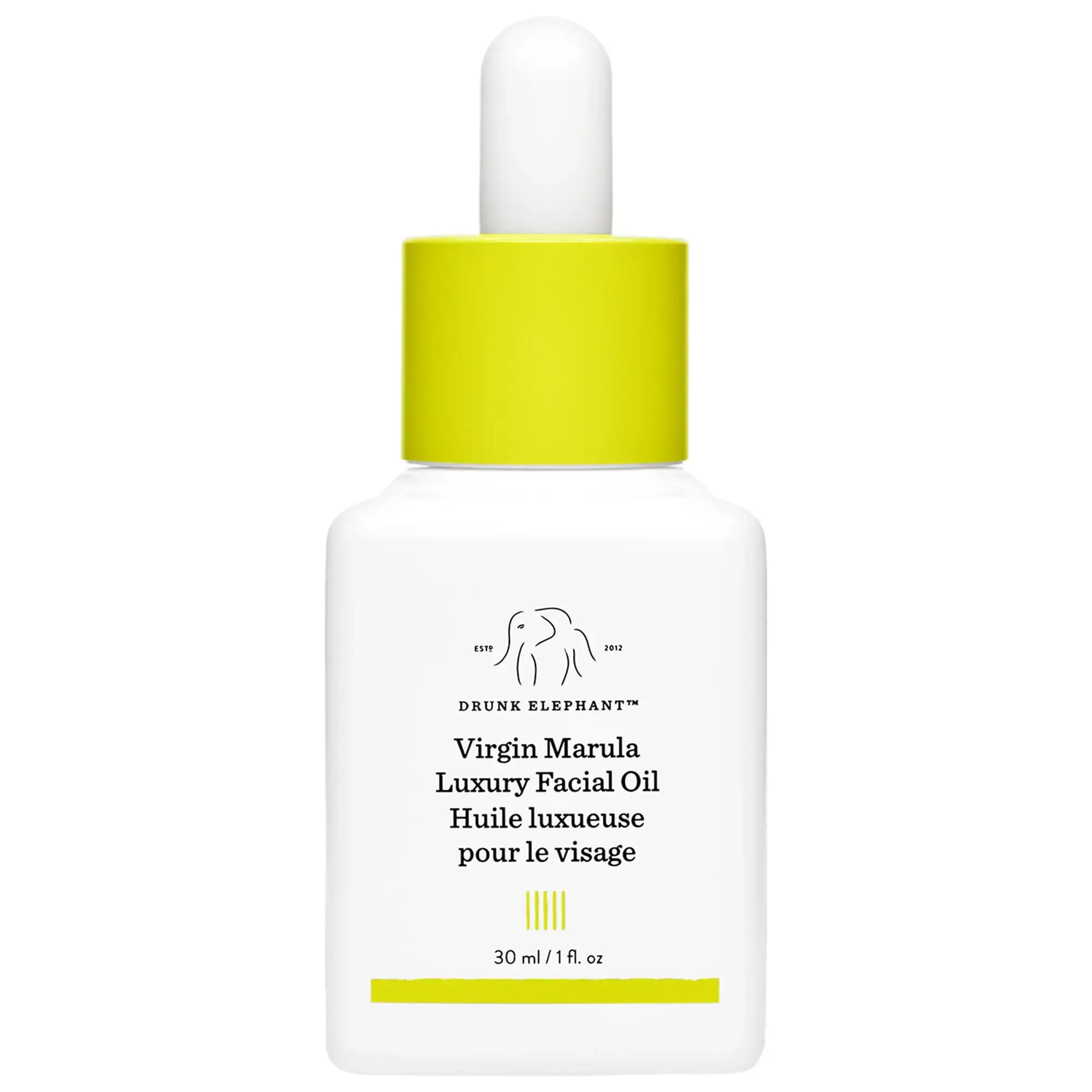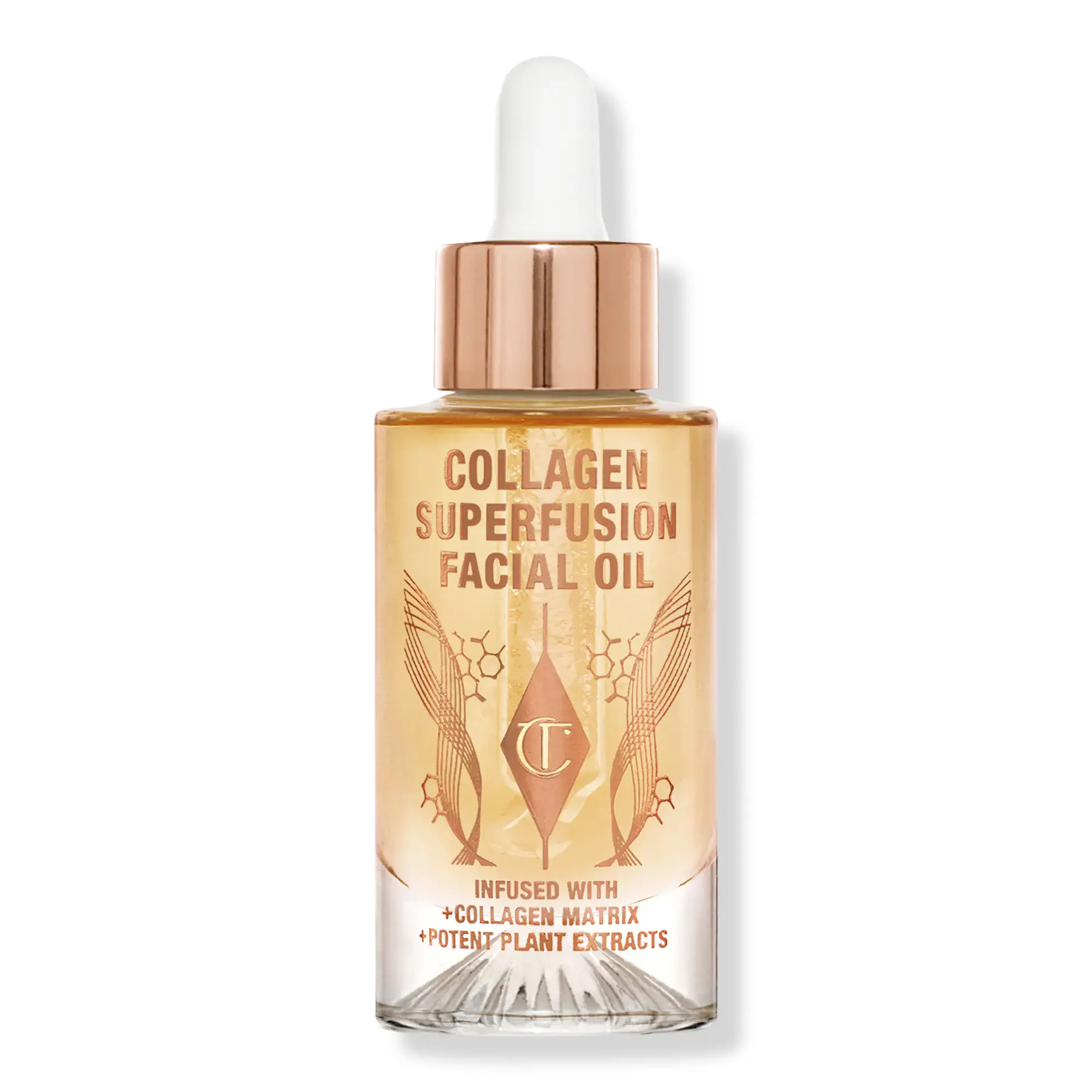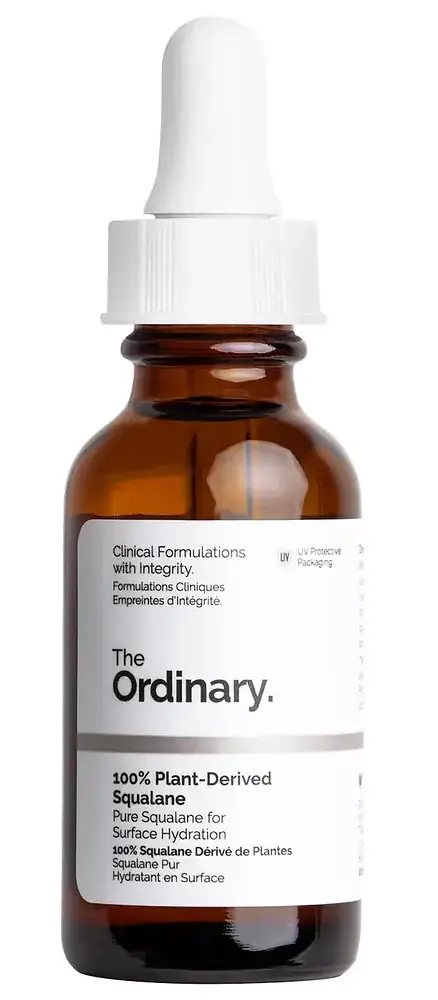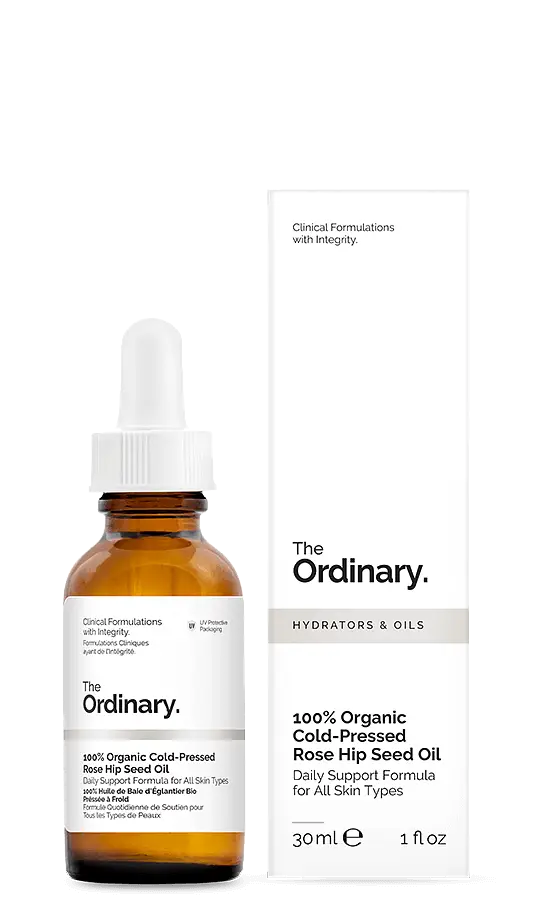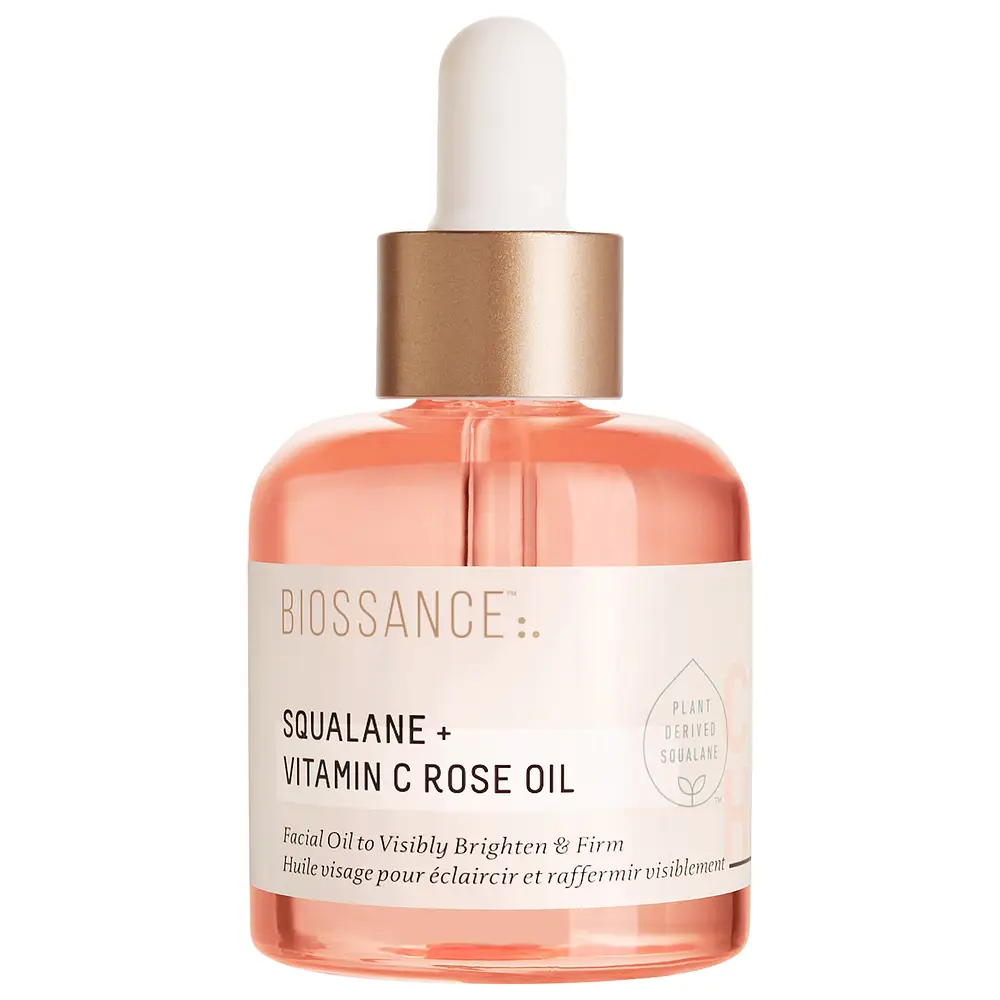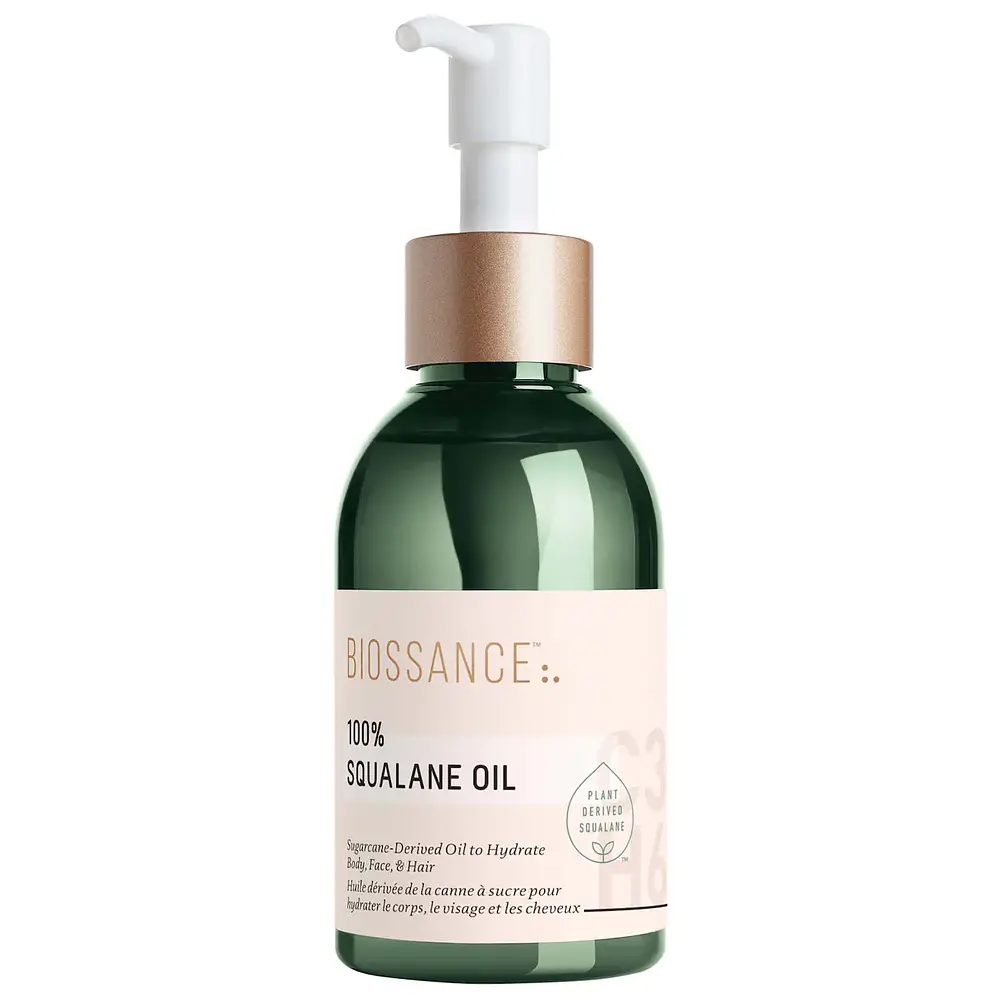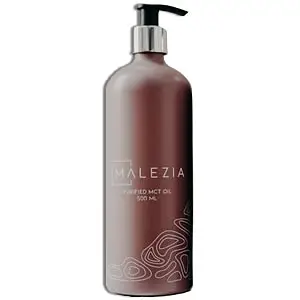Products Scan Our science '%20fill='black'/%3e%3c/svg%3e)
Skincare 
Bath & Body 
Make up 
Trending 
Skincare
Moisturizers
Treatments
Cleansers
Eye Care
Bath & Body
Make up
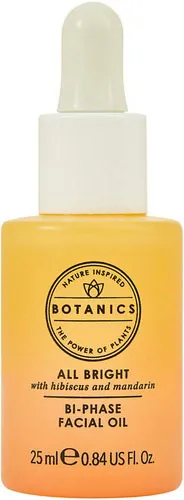
Hover to see details. On mobile? Tap for ingredient stories!
Full Ingredient List (INCI):






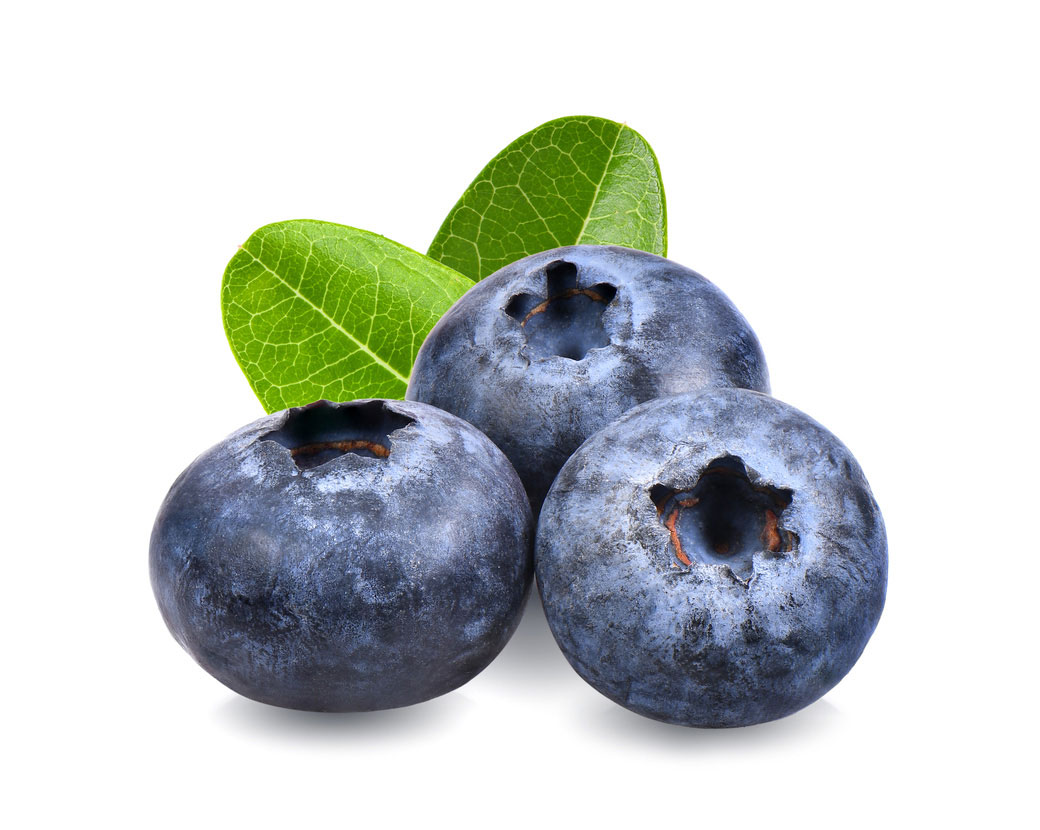













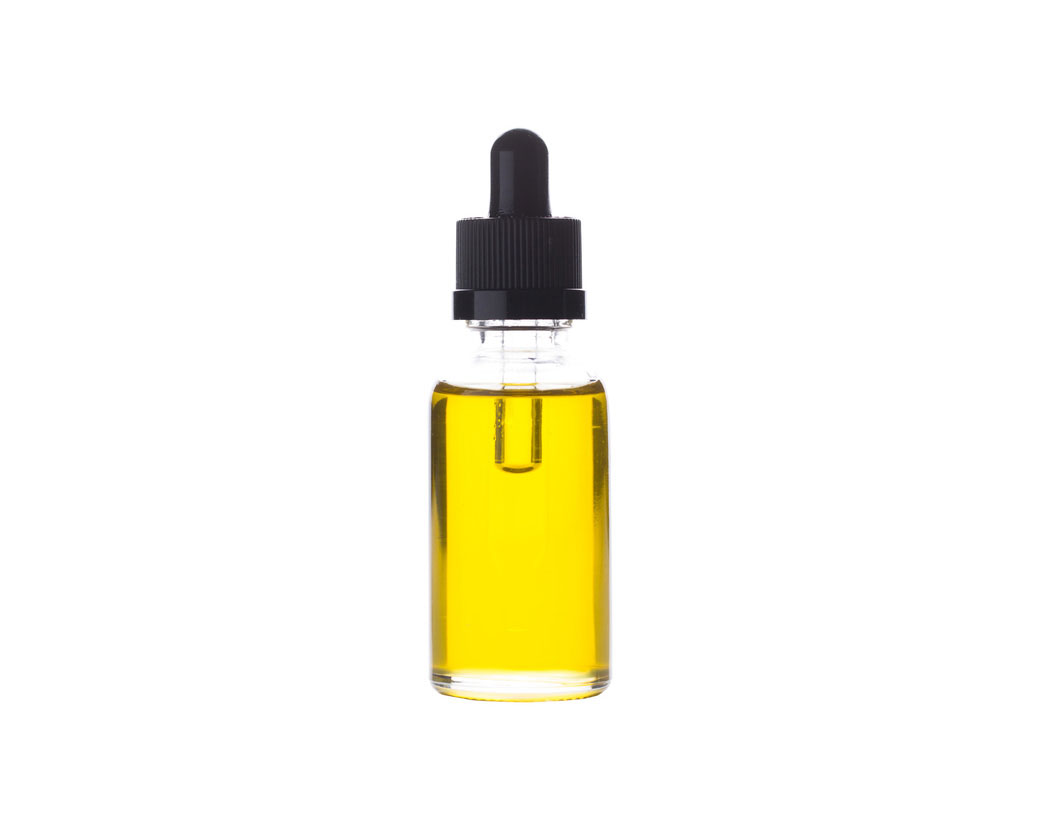























According to CreamScan analysis, Botanics All Bright Bi-Phase Oil is exceptionally moisturizing, with the highest possible moisturizing rating of 10.0 out of 10.
Is it more humectant or occlusive? This is one of the most moisturizing products on the market, with a maximum humectancy of 10 out of 10, primarily due to the substantial concentration of Glycerin (est. ≈11.0%) and Saccharum Officinarum (Sugarcane) Extract (est. ≈2.0%), and a maximum occlusivity of 10 out of 10, solely because of the significant content of Carthamus Tinctorius (Safflower) Seed Oil (est. ≈45.0%).
This type of moisturizer is ideal for people with dry to very dry skin who want intense hydration. It combines a high concentration of humectants with an exceptional level of occlusive ingredients to provide effective dual-action moisturizing specifically for very dry skin.
The occlusive profile of Botanics All Bright Bi-Phase Oil suggests a rich, thick texture, making it perfectly suited for very dry skin.
Please refer to the Ratings section below for details of the moisturizing rating calculation.
We estimate that Botanics All Bright Bi-Phase Oil is rich (> 3%) in antioxidants, specifically Carthamus Tinctorius (Safflower) Seed Oil (est. ≈45.0%), Vaccinium Myrtillus Fruit/Leaf Extract (est. ≈6.0%), Hibiscus Sabdariffa Flower Extract (est. ≈4.0%), and others.
A key benefit of antioxidants is their ability to reduce oxidative stress caused by free radicals and therefore prevent accelerated skin aging. Studies also show that antioxidants can protect against environmental damage such as UV radiation and pollution, and help reduce inflammation and skin redness.
📌 Please note that this is not a complete list of benefits. We are in the process of enhancing our model to incorporate anti-pigmentation, exfoliation and anti-acne ratings.
With exceptional occlusivity, this product is optimal for moisturizing dry and very dry skin but may be too thick for other skin types, including normal, and especially combination and oily skin.
If you have oily, combination, or normal skin and are considering purchasing this product for the first time, it might be a good idea to try a sample before buying.
If one of your main reasons for choosing Botanics All Bright Bi-Phase Oil is its potential anti-aging effects, please note that, according to CreamScan analysis, it currently has a zero anti-wrinkle rating.
It contains Ascorbyl Glucoside, an ingredient often marketed as effective in reducing wrinkles. However, the studies supporting the anti-wrinkle claims of Ascorbyl Glucoside provide insufficient evidence of its efficacy according to CreamScan Research Evaluation Standards.
While this does not categorically rule out the possibility that Ascorbyl Glucoside may reduce wrinkles, its efficacy is not supported by convincing, vehicle-controlled, double-blind clinical studies - at least none that were available to the CreamScan team at the time of publication.
Therefore, this ingredient does not generate the anti-wrinkle rating.
📌 Moisturizers, when used regularly, are proven to prevent wrinkle formation and even reduce existing wrinkles. Therefore, this product, like any other moisturizer, can deliver some anti-wrinkle effects through its moisturizing action.
Please refer to the Ratings section below for details of the anti-wrinkle rating calculation.
|
Est. %
The Estimated % is our algorithm-based assumption about an ingredient's concentration in a formula. Learn more The Estimated % is our algorithm-based assumption about an ingredient's concentration in a formula. Learn more | Ingredient | Origin | Functions | |
|---|---|---|---|---|
| 45 | Carthamus Tinctorius (Safflower) Seed Oil  A fatty oil pressed from safflower seeds that is used as an occlusive moisturizer and emollient. It contains unusually high amounts of linoleic acid (up to 70%), as well as antioxidant compounds such as vitamin E, phytosterols, and phenolics. Carthamus Tinctorius (Safflower) Seed Oil  A fatty oil pressed from safflower seeds that is used as an occlusive moisturizer and emollient. It contains unusually high amounts of linoleic acid (up to 70%), as well as antioxidant compounds such as vitamin E, phytosterols, and phenolics. | Botanical Ingredients derived from plants, mosses, and lichens: extracts, oils, powders, juices and other types of processed plant materials. Botanical Ingredients derived from plants, mosses, and lichens: extracts, oils, powders, juices and other types of processed plant materials. | Moisturizing (Occlusive) Occlusives are moisturizing ingredients that seal moisture into the skin, forming a water-resistant barrier. Moisturizing (Occlusive) Occlusives are moisturizing ingredients that seal moisture into the skin, forming a water-resistant barrier. Antioxidant Antioxidants reduce the oxidative stress caused by free radicals and prevent accelerated skin aging. Antioxidant Antioxidants reduce the oxidative stress caused by free radicals and prevent accelerated skin aging. Emollient Emollients fill the micro-cracks in the skin and leave it feeling soft and pleasant to the touch. Emollients are often mistakenly perceived as moisturizing ingredients. Emollient Emollients fill the micro-cracks in the skin and leave it feeling soft and pleasant to the touch. Emollients are often mistakenly perceived as moisturizing ingredients. Fragrance Fragrance ingredients add scent to a product or hide ('mask') the undesired aroma of other ingredients. Fragrance Fragrance ingredients add scent to a product or hide ('mask') the undesired aroma of other ingredients. | |
| 22 | Water  The most used ingredient in skincare. Its concentration defines the product texture: rich creams may have about 50% of water while a light jelly about 90%. Water doesn’t moisturize the skin by itself and is used in skincare as a solvent for other ingredients. Water  The most used ingredient in skincare. Its concentration defines the product texture: rich creams may have about 50% of water while a light jelly about 90%. Water doesn’t moisturize the skin by itself and is used in skincare as a solvent for other ingredients. | Naturally occurring These are ingredients initially present in nature, such as elements (Zinc, Gold, or Silver), minerals, or water. Naturally occurring These are ingredients initially present in nature, such as elements (Zinc, Gold, or Silver), minerals, or water. | Formula helper
Formula helper
| |
| 11 | Glycerin  The most popular moisturizing ingredient in the world. It is a powerful humectant – cheap yet very effective. Glycerin  The most popular moisturizing ingredient in the world. It is a powerful humectant – cheap yet very effective. | Botanical Ingredients derived from plants, mosses, and lichens: extracts, oils, powders, juices and other types of processed plant materials. Botanical Ingredients derived from plants, mosses, and lichens: extracts, oils, powders, juices and other types of processed plant materials. Synthetic All kinds of ingredients formulated or produced by a chemical process, or those that have a chemical modification in their structure. Synthetic All kinds of ingredients formulated or produced by a chemical process, or those that have a chemical modification in their structure. Animal Ingredients derived from animals (including birds, fish, crustaceans, mollusks, and insects) or produced by animals (e.g. dairy- and egg-derived ingredients, bee products, silk, pearls, etc.) Animal Ingredients derived from animals (including birds, fish, crustaceans, mollusks, and insects) or produced by animals (e.g. dairy- and egg-derived ingredients, bee products, silk, pearls, etc.) | Moisturizing (Humectant) Humectants are moisturizing ingredients that draw moisture to the skin, either from deeper layers or from the environment (when it's humid). Moisturizing (Humectant) Humectants are moisturizing ingredients that draw moisture to the skin, either from deeper layers or from the environment (when it's humid). Emollient Emollients fill the micro-cracks in the skin and leave it feeling soft and pleasant to the touch. Emollients are often mistakenly perceived as moisturizing ingredients. Emollient Emollients fill the micro-cracks in the skin and leave it feeling soft and pleasant to the touch. Emollients are often mistakenly perceived as moisturizing ingredients. Fragrance Fragrance ingredients add scent to a product or hide ('mask') the undesired aroma of other ingredients. Fragrance Fragrance ingredients add scent to a product or hide ('mask') the undesired aroma of other ingredients. Formula helper
Formula helper
| |
| 6 | Vaccinium Myrtillus Fruit/Leaf Extract  Derived from the berries and leaves of the bilberry plant, this powerful antioxidant, astringent, and refreshing extract is rich in anthocyanins, flavonoids, and tannins. Vaccinium Myrtillus Fruit/Leaf Extract  Derived from the berries and leaves of the bilberry plant, this powerful antioxidant, astringent, and refreshing extract is rich in anthocyanins, flavonoids, and tannins. | Botanical Ingredients derived from plants, mosses, and lichens: extracts, oils, powders, juices and other types of processed plant materials. Botanical Ingredients derived from plants, mosses, and lichens: extracts, oils, powders, juices and other types of processed plant materials. | Antioxidant Antioxidants reduce the oxidative stress caused by free radicals and prevent accelerated skin aging. Antioxidant Antioxidants reduce the oxidative stress caused by free radicals and prevent accelerated skin aging. Astringent Astringent ingredients provide the skin with a tightened feeling, help to reduce the appearance of large pores, and assist in the healing of small cuts and wounds. Astringent Astringent ingredients provide the skin with a tightened feeling, help to reduce the appearance of large pores, and assist in the healing of small cuts and wounds. Refreshing Refreshing ingredients leave the skin feeling refreshed and 'awake'. Refreshing Refreshing ingredients leave the skin feeling refreshed and 'awake'. | |
| 4 | Hibiscus Sabdariffa Flower Extract  Derived from bright red hibiscus flowers, this extract contains anthocyanins (red plant pigments), antioxidant flavonoids, and high amounts of organic acids. Hibiscus Sabdariffa Flower Extract  Derived from bright red hibiscus flowers, this extract contains anthocyanins (red plant pigments), antioxidant flavonoids, and high amounts of organic acids. | Botanical Ingredients derived from plants, mosses, and lichens: extracts, oils, powders, juices and other types of processed plant materials. Botanical Ingredients derived from plants, mosses, and lichens: extracts, oils, powders, juices and other types of processed plant materials. | Antioxidant Antioxidants reduce the oxidative stress caused by free radicals and prevent accelerated skin aging. Antioxidant Antioxidants reduce the oxidative stress caused by free radicals and prevent accelerated skin aging. Antimicrobial Antimicrobials prevent the growth of harmful microorganisms on the skin. Antimicrobial Antimicrobials prevent the growth of harmful microorganisms on the skin. | |
| 3 | Limonene  One of the most used fragrances in skincare products. It is produced from the peels of citrus fruits and has a fresh, pleasant, citrusy smell. People who are sensitive to citrus should try to avoid it, or at least do a patch test before using it. Limonene  One of the most used fragrances in skincare products. It is produced from the peels of citrus fruits and has a fresh, pleasant, citrusy smell. People who are sensitive to citrus should try to avoid it, or at least do a patch test before using it. | Botanical Ingredients derived from plants, mosses, and lichens: extracts, oils, powders, juices and other types of processed plant materials. Botanical Ingredients derived from plants, mosses, and lichens: extracts, oils, powders, juices and other types of processed plant materials. Synthetic All kinds of ingredients formulated or produced by a chemical process, or those that have a chemical modification in their structure. Synthetic All kinds of ingredients formulated or produced by a chemical process, or those that have a chemical modification in their structure. | Fragrance Fragrance ingredients add scent to a product or hide ('mask') the undesired aroma of other ingredients. Fragrance Fragrance ingredients add scent to a product or hide ('mask') the undesired aroma of other ingredients. Formula helper
Formula helper
| |
| 2 | Saccharum Officinarum (Sugarcane) Extract  An antioxidant extract from sugarcane, the famous crop used to make sugar. It acts as a humectant and exfoliating agent – the little sugar crystals mechanically remove dead skin cells from the skin’s surface. Saccharum Officinarum (Sugarcane) Extract  An antioxidant extract from sugarcane, the famous crop used to make sugar. It acts as a humectant and exfoliating agent – the little sugar crystals mechanically remove dead skin cells from the skin’s surface. | Botanical Ingredients derived from plants, mosses, and lichens: extracts, oils, powders, juices and other types of processed plant materials. Botanical Ingredients derived from plants, mosses, and lichens: extracts, oils, powders, juices and other types of processed plant materials. | Moisturizing (Humectant) Humectants are moisturizing ingredients that draw moisture to the skin, either from deeper layers or from the environment (when it's humid). Moisturizing (Humectant) Humectants are moisturizing ingredients that draw moisture to the skin, either from deeper layers or from the environment (when it's humid). Antioxidant Antioxidants reduce the oxidative stress caused by free radicals and prevent accelerated skin aging. Antioxidant Antioxidants reduce the oxidative stress caused by free radicals and prevent accelerated skin aging. Exfoliant Exfoliants remove dead skin cells from the surface of the skin via acid-based chemical reactions (e.g., AHA or BHA). Exfoliant Exfoliants remove dead skin cells from the surface of the skin via acid-based chemical reactions (e.g., AHA or BHA). Formula helper
Formula helper
| |
| 1.5 | Potassium Hydroxide  A very alkaline ingredient, meaning that it has a high pH. Potassium hydroxide is therefore useful in bringing a low pH in a cosmetic product up to a more neutral, skin-safe level. Potassium Hydroxide  A very alkaline ingredient, meaning that it has a high pH. Potassium hydroxide is therefore useful in bringing a low pH in a cosmetic product up to a more neutral, skin-safe level. | Synthetic All kinds of ingredients formulated or produced by a chemical process, or those that have a chemical modification in their structure. Synthetic All kinds of ingredients formulated or produced by a chemical process, or those that have a chemical modification in their structure. | Formula helper
Formula helper
| |
| 1 | Phenoxyethanol  The most frequently used preservative in skincare. It is a clear, oil-like liquid synthetic substance that protects products from harmful bacteria and yeast, whilst still leaving skin microflora unharmed. It is confirmed by research to be harmless. Phenoxyethanol  The most frequently used preservative in skincare. It is a clear, oil-like liquid synthetic substance that protects products from harmful bacteria and yeast, whilst still leaving skin microflora unharmed. It is confirmed by research to be harmless. | Synthetic All kinds of ingredients formulated or produced by a chemical process, or those that have a chemical modification in their structure. Synthetic All kinds of ingredients formulated or produced by a chemical process, or those that have a chemical modification in their structure. | Antimicrobial Antimicrobials prevent the growth of harmful microorganisms on the skin. Antimicrobial Antimicrobials prevent the growth of harmful microorganisms on the skin. Preservative Preservatives prevent the growth of bacteria and fungi in a product. Preservative Preservatives prevent the growth of bacteria and fungi in a product. | |
| 0.3 | Tocopheryl Acetate  An antioxidant derivative of tocopherol (vitamin E). It helps to protect cells from free radicals and UV damage through the conversion to active vitamin E in the skin. It is more stable than tocopherol. Tocopheryl Acetate  An antioxidant derivative of tocopherol (vitamin E). It helps to protect cells from free radicals and UV damage through the conversion to active vitamin E in the skin. It is more stable than tocopherol. | Botanical Ingredients derived from plants, mosses, and lichens: extracts, oils, powders, juices and other types of processed plant materials. Botanical Ingredients derived from plants, mosses, and lichens: extracts, oils, powders, juices and other types of processed plant materials. Synthetic All kinds of ingredients formulated or produced by a chemical process, or those that have a chemical modification in their structure. Synthetic All kinds of ingredients formulated or produced by a chemical process, or those that have a chemical modification in their structure. | Antioxidant Antioxidants reduce the oxidative stress caused by free radicals and prevent accelerated skin aging. Antioxidant Antioxidants reduce the oxidative stress caused by free radicals and prevent accelerated skin aging. | |
| 0.3 | | Botanical Ingredients derived from plants, mosses, and lichens: extracts, oils, powders, juices and other types of processed plant materials. Botanical Ingredients derived from plants, mosses, and lichens: extracts, oils, powders, juices and other types of processed plant materials. | Emollient Emollients fill the micro-cracks in the skin and leave it feeling soft and pleasant to the touch. Emollients are often mistakenly perceived as moisturizing ingredients. Emollient Emollients fill the micro-cracks in the skin and leave it feeling soft and pleasant to the touch. Emollients are often mistakenly perceived as moisturizing ingredients. Fragrance Fragrance ingredients add scent to a product or hide ('mask') the undesired aroma of other ingredients. Fragrance Fragrance ingredients add scent to a product or hide ('mask') the undesired aroma of other ingredients. Flavor Flavor ingredients bring sweetness to a product or are used to recreate various tastes. Flavor Flavor ingredients bring sweetness to a product or are used to recreate various tastes. | |
| 0.3 | Citrus Limon (Lemon) Fruit Extract  A fragrant extract from lemon peels that contains various antioxidant flavonoids, organic acids, and limonoids – which are currently under investigation as potential anti-wrinkle and anti-pigment compounds. Citrus Limon (Lemon) Fruit Extract  A fragrant extract from lemon peels that contains various antioxidant flavonoids, organic acids, and limonoids – which are currently under investigation as potential anti-wrinkle and anti-pigment compounds. | Botanical Ingredients derived from plants, mosses, and lichens: extracts, oils, powders, juices and other types of processed plant materials. Botanical Ingredients derived from plants, mosses, and lichens: extracts, oils, powders, juices and other types of processed plant materials. | Fragrance Fragrance ingredients add scent to a product or hide ('mask') the undesired aroma of other ingredients. Fragrance Fragrance ingredients add scent to a product or hide ('mask') the undesired aroma of other ingredients. | |
| 0.3 | Citrus Aurantium Dulcis (Orange) Fruit Extract  An extract from the fruit of the sweet orange. It contains fragrant sweet orange essential oil, high amounts of antioxidant flavonoids (mainly hesperidin), and carotenoids – which give it the orange color. Citrus Aurantium Dulcis (Orange) Fruit Extract  An extract from the fruit of the sweet orange. It contains fragrant sweet orange essential oil, high amounts of antioxidant flavonoids (mainly hesperidin), and carotenoids – which give it the orange color. | Botanical Ingredients derived from plants, mosses, and lichens: extracts, oils, powders, juices and other types of processed plant materials. Botanical Ingredients derived from plants, mosses, and lichens: extracts, oils, powders, juices and other types of processed plant materials. | Antioxidant Antioxidants reduce the oxidative stress caused by free radicals and prevent accelerated skin aging. Antioxidant Antioxidants reduce the oxidative stress caused by free radicals and prevent accelerated skin aging. Fragrance Fragrance ingredients add scent to a product or hide ('mask') the undesired aroma of other ingredients. Fragrance Fragrance ingredients add scent to a product or hide ('mask') the undesired aroma of other ingredients. | |
| 0.3 | Ascorbyl Glucoside  A derivative of vitamin C. It is more stable and less irritating than ascorbic acid. There are unfortunately no clinical studies on ascorbyl glucoside’s anti-pigment or anti-acne efficacy alone. Ascorbyl Glucoside  A derivative of vitamin C. It is more stable and less irritating than ascorbic acid. There are unfortunately no clinical studies on ascorbyl glucoside’s anti-pigment or anti-acne efficacy alone. | Botanical Ingredients derived from plants, mosses, and lichens: extracts, oils, powders, juices and other types of processed plant materials. Botanical Ingredients derived from plants, mosses, and lichens: extracts, oils, powders, juices and other types of processed plant materials. Synthetic All kinds of ingredients formulated or produced by a chemical process, or those that have a chemical modification in their structure. Synthetic All kinds of ingredients formulated or produced by a chemical process, or those that have a chemical modification in their structure. | Antioxidant Antioxidants reduce the oxidative stress caused by free radicals and prevent accelerated skin aging. Antioxidant Antioxidants reduce the oxidative stress caused by free radicals and prevent accelerated skin aging. Anti-Wrinkle Anti-wrinkle ingredients prevent the formation or reduce the appearance of wrinkles. Anti-Wrinkle Anti-wrinkle ingredients prevent the formation or reduce the appearance of wrinkles. Anti-Pigmentation Anti-pigmentation ingredients help to even skin tone by reducing the intensity of dark spots and hyperpigmentation. Anti-Pigmentation Anti-pigmentation ingredients help to even skin tone by reducing the intensity of dark spots and hyperpigmentation. | |
| 0.3 | Sodium Chloride  You’re definitely familiar with sodium chloride, even if you don’t think you are. It’s table salt! Salt works well with some cleansing ingredients (surfactants) to thicken them into gels. It also acts as a stabilizer for water-in-oil emulsions. Sodium Chloride  You’re definitely familiar with sodium chloride, even if you don’t think you are. It’s table salt! Salt works well with some cleansing ingredients (surfactants) to thicken them into gels. It also acts as a stabilizer for water-in-oil emulsions. | Naturally occurring These are ingredients initially present in nature, such as elements (Zinc, Gold, or Silver), minerals, or water. Naturally occurring These are ingredients initially present in nature, such as elements (Zinc, Gold, or Silver), minerals, or water. Synthetic All kinds of ingredients formulated or produced by a chemical process, or those that have a chemical modification in their structure. Synthetic All kinds of ingredients formulated or produced by a chemical process, or those that have a chemical modification in their structure. | Fragrance Fragrance ingredients add scent to a product or hide ('mask') the undesired aroma of other ingredients. Fragrance Fragrance ingredients add scent to a product or hide ('mask') the undesired aroma of other ingredients. Flavor Flavor ingredients bring sweetness to a product or are used to recreate various tastes. Flavor Flavor ingredients bring sweetness to a product or are used to recreate various tastes. Formula helper
Formula helper
| |
| 0.3 | Acer Saccharum (Sugar Maple) Extract  An antioxidant extract from sugar maple bark and sap – the same sweet sap used to make maple syrup. It has a faint vanilla smell and is used in skincare for its exfoliating properties. This is because of the small sugar crystals present in the extract. Acer Saccharum (Sugar Maple) Extract  An antioxidant extract from sugar maple bark and sap – the same sweet sap used to make maple syrup. It has a faint vanilla smell and is used in skincare for its exfoliating properties. This is because of the small sugar crystals present in the extract. | Botanical Ingredients derived from plants, mosses, and lichens: extracts, oils, powders, juices and other types of processed plant materials. Botanical Ingredients derived from plants, mosses, and lichens: extracts, oils, powders, juices and other types of processed plant materials. | Antioxidant Antioxidants reduce the oxidative stress caused by free radicals and prevent accelerated skin aging. Antioxidant Antioxidants reduce the oxidative stress caused by free radicals and prevent accelerated skin aging. Exfoliant Exfoliants remove dead skin cells from the surface of the skin via acid-based chemical reactions (e.g., AHA or BHA). Exfoliant Exfoliants remove dead skin cells from the surface of the skin via acid-based chemical reactions (e.g., AHA or BHA). | |
| 0.3 | Sodium Benzoate  A preservative that usually works in combination with other preservatives. It has to be at low pH (<5.5) to be effective. Sodium Benzoate  A preservative that usually works in combination with other preservatives. It has to be at low pH (<5.5) to be effective. | Synthetic All kinds of ingredients formulated or produced by a chemical process, or those that have a chemical modification in their structure. Synthetic All kinds of ingredients formulated or produced by a chemical process, or those that have a chemical modification in their structure. | Fragrance Fragrance ingredients add scent to a product or hide ('mask') the undesired aroma of other ingredients. Fragrance Fragrance ingredients add scent to a product or hide ('mask') the undesired aroma of other ingredients. Preservative Preservatives prevent the growth of bacteria and fungi in a product. Preservative Preservatives prevent the growth of bacteria and fungi in a product. Formula helper
Formula helper
| |
| 0.3 | Tetrasodium EDTA  One of the most common synthetic chelators. It can reduce the 'hardness' of water and so is often used in rinse-off products. Tetrasodium EDTA  One of the most common synthetic chelators. It can reduce the 'hardness' of water and so is often used in rinse-off products. | Synthetic All kinds of ingredients formulated or produced by a chemical process, or those that have a chemical modification in their structure. Synthetic All kinds of ingredients formulated or produced by a chemical process, or those that have a chemical modification in their structure. | Formula helper
Formula helper
| |
| 0.3 | Linalool  A fragrant, volatile compound naturally present in many essential oils. It has a pleasant scent and is often used in skincare products as a fragrance. People with sensitive skin should try to avoid it, or at least do a patch test before using it. Linalool  A fragrant, volatile compound naturally present in many essential oils. It has a pleasant scent and is often used in skincare products as a fragrance. People with sensitive skin should try to avoid it, or at least do a patch test before using it. | Botanical Ingredients derived from plants, mosses, and lichens: extracts, oils, powders, juices and other types of processed plant materials. Botanical Ingredients derived from plants, mosses, and lichens: extracts, oils, powders, juices and other types of processed plant materials. Synthetic All kinds of ingredients formulated or produced by a chemical process, or those that have a chemical modification in their structure. Synthetic All kinds of ingredients formulated or produced by a chemical process, or those that have a chemical modification in their structure. | Fragrance Fragrance ingredients add scent to a product or hide ('mask') the undesired aroma of other ingredients. Fragrance Fragrance ingredients add scent to a product or hide ('mask') the undesired aroma of other ingredients. | |
| 0.3 | Benzoic Acid  A preservative effective against fungi, yeast, and some bacteria. It is commonly paired with phenoxyethanol to create a broad spectrum preservation system. Benzoic acid can also serve as a pH adjuster, fragrance, and bulking agent. Benzoic Acid  A preservative effective against fungi, yeast, and some bacteria. It is commonly paired with phenoxyethanol to create a broad spectrum preservation system. Benzoic acid can also serve as a pH adjuster, fragrance, and bulking agent. | Botanical Ingredients derived from plants, mosses, and lichens: extracts, oils, powders, juices and other types of processed plant materials. Botanical Ingredients derived from plants, mosses, and lichens: extracts, oils, powders, juices and other types of processed plant materials. Synthetic All kinds of ingredients formulated or produced by a chemical process, or those that have a chemical modification in their structure. Synthetic All kinds of ingredients formulated or produced by a chemical process, or those that have a chemical modification in their structure. | Fragrance Fragrance ingredients add scent to a product or hide ('mask') the undesired aroma of other ingredients. Fragrance Fragrance ingredients add scent to a product or hide ('mask') the undesired aroma of other ingredients. Preservative Preservatives prevent the growth of bacteria and fungi in a product. Preservative Preservatives prevent the growth of bacteria and fungi in a product. Formula helper
Formula helper
| |
| 0.3 | Dehydroacetic Acid  A globally approved preservative ingredient. It is a powerful fungicide and a moderate bactericide, which makes it a broad-spectrum preservative. Because it is mildly effective against bacteria, it is often paired with stronger bactericides. Dehydroacetic Acid  A globally approved preservative ingredient. It is a powerful fungicide and a moderate bactericide, which makes it a broad-spectrum preservative. Because it is mildly effective against bacteria, it is often paired with stronger bactericides. | Synthetic All kinds of ingredients formulated or produced by a chemical process, or those that have a chemical modification in their structure. Synthetic All kinds of ingredients formulated or produced by a chemical process, or those that have a chemical modification in their structure. | Preservative Preservatives prevent the growth of bacteria and fungi in a product. Preservative Preservatives prevent the growth of bacteria and fungi in a product. | |
| 0.3 | Ethylhexylglycerin  A preservative booster derived from glycerin. It is commonly paired with other preservatives to improve their efficacy. Ethylhexylglycerin is also a humectant due to its chemical base of glycerin. Ethylhexylglycerin  A preservative booster derived from glycerin. It is commonly paired with other preservatives to improve their efficacy. Ethylhexylglycerin is also a humectant due to its chemical base of glycerin. | Synthetic All kinds of ingredients formulated or produced by a chemical process, or those that have a chemical modification in their structure. Synthetic All kinds of ingredients formulated or produced by a chemical process, or those that have a chemical modification in their structure. | Moisturizing (Humectant) Humectants are moisturizing ingredients that draw moisture to the skin, either from deeper layers or from the environment (when it's humid). Moisturizing (Humectant) Humectants are moisturizing ingredients that draw moisture to the skin, either from deeper layers or from the environment (when it's humid). Preservative Preservatives prevent the growth of bacteria and fungi in a product. Preservative Preservatives prevent the growth of bacteria and fungi in a product. | |
| 45  Carthamus Tinctorius (Safflower) Seed Oil Function: Moisturizing (Occlusive), Moisturizing (Occlusive) Occlusives are moisturizing ingredients that seal moisture into the skin, forming a water-resistant barrier. Moisturizing (Occlusive), Moisturizing (Occlusive) Occlusives are moisturizing ingredients that seal moisture into the skin, forming a water-resistant barrier. Antioxidant, Antioxidant Antioxidants reduce the oxidative stress caused by free radicals and prevent accelerated skin aging. Antioxidant, Antioxidant Antioxidants reduce the oxidative stress caused by free radicals and prevent accelerated skin aging. Emollient, Emollient Emollients fill the micro-cracks in the skin and leave it feeling soft and pleasant to the touch. Emollients are often mistakenly perceived as moisturizing ingredients. Emollient, Emollient Emollients fill the micro-cracks in the skin and leave it feeling soft and pleasant to the touch. Emollients are often mistakenly perceived as moisturizing ingredients. Fragrance Fragrance Fragrance ingredients add scent to a product or hide ('mask') the undesired aroma of other ingredients. Fragrance Fragrance Fragrance ingredients add scent to a product or hide ('mask') the undesired aroma of other ingredients. Origin: Botanical Botanical Ingredients derived from plants, mosses, and lichens: extracts, oils, powders, juices and other types of processed plant materials. Botanical Botanical Ingredients derived from plants, mosses, and lichens: extracts, oils, powders, juices and other types of processed plant materials. |
| 22  Water Function: Formula helper Formula helper
Formula helper Formula helper
Origin: Naturally occurring Naturally occurring These are ingredients initially present in nature, such as elements (Zinc, Gold, or Silver), minerals, or water. Naturally occurring Naturally occurring These are ingredients initially present in nature, such as elements (Zinc, Gold, or Silver), minerals, or water. |
| 11  Glycerin Function: Moisturizing (Humectant), Moisturizing (Humectant) Humectants are moisturizing ingredients that draw moisture to the skin, either from deeper layers or from the environment (when it's humid). Moisturizing (Humectant), Moisturizing (Humectant) Humectants are moisturizing ingredients that draw moisture to the skin, either from deeper layers or from the environment (when it's humid). Emollient, Emollient Emollients fill the micro-cracks in the skin and leave it feeling soft and pleasant to the touch. Emollients are often mistakenly perceived as moisturizing ingredients. Emollient, Emollient Emollients fill the micro-cracks in the skin and leave it feeling soft and pleasant to the touch. Emollients are often mistakenly perceived as moisturizing ingredients. Fragrance, Fragrance Fragrance ingredients add scent to a product or hide ('mask') the undesired aroma of other ingredients. Fragrance, Fragrance Fragrance ingredients add scent to a product or hide ('mask') the undesired aroma of other ingredients. Formula helper Formula helper
Formula helper Formula helper
Origin: Botanical, Botanical Ingredients derived from plants, mosses, and lichens: extracts, oils, powders, juices and other types of processed plant materials. Botanical, Botanical Ingredients derived from plants, mosses, and lichens: extracts, oils, powders, juices and other types of processed plant materials. Synthetic, Synthetic All kinds of ingredients formulated or produced by a chemical process, or those that have a chemical modification in their structure. Synthetic, Synthetic All kinds of ingredients formulated or produced by a chemical process, or those that have a chemical modification in their structure. Animal Animal Ingredients derived from animals (including birds, fish, crustaceans, mollusks, and insects) or produced by animals (e.g. dairy- and egg-derived ingredients, bee products, silk, pearls, etc.) Animal Animal Ingredients derived from animals (including birds, fish, crustaceans, mollusks, and insects) or produced by animals (e.g. dairy- and egg-derived ingredients, bee products, silk, pearls, etc.) |
| 6  Vaccinium Myrtillus Fruit/Leaf Extract Function: Antioxidant, Antioxidant Antioxidants reduce the oxidative stress caused by free radicals and prevent accelerated skin aging. Antioxidant, Antioxidant Antioxidants reduce the oxidative stress caused by free radicals and prevent accelerated skin aging. Astringent, Astringent Astringent ingredients provide the skin with a tightened feeling, help to reduce the appearance of large pores, and assist in the healing of small cuts and wounds. Astringent, Astringent Astringent ingredients provide the skin with a tightened feeling, help to reduce the appearance of large pores, and assist in the healing of small cuts and wounds. Refreshing Refreshing Refreshing ingredients leave the skin feeling refreshed and 'awake'. Refreshing Refreshing Refreshing ingredients leave the skin feeling refreshed and 'awake'. Origin: Botanical Botanical Ingredients derived from plants, mosses, and lichens: extracts, oils, powders, juices and other types of processed plant materials. Botanical Botanical Ingredients derived from plants, mosses, and lichens: extracts, oils, powders, juices and other types of processed plant materials. |
| 4  Hibiscus Sabdariffa Flower Extract Function: Antioxidant, Antioxidant Antioxidants reduce the oxidative stress caused by free radicals and prevent accelerated skin aging. Antioxidant, Antioxidant Antioxidants reduce the oxidative stress caused by free radicals and prevent accelerated skin aging. Antimicrobial Antimicrobial Antimicrobials prevent the growth of harmful microorganisms on the skin. Antimicrobial Antimicrobial Antimicrobials prevent the growth of harmful microorganisms on the skin. Origin: Botanical Botanical Ingredients derived from plants, mosses, and lichens: extracts, oils, powders, juices and other types of processed plant materials. Botanical Botanical Ingredients derived from plants, mosses, and lichens: extracts, oils, powders, juices and other types of processed plant materials. |
| 3  Limonene Function: Fragrance, Fragrance Fragrance ingredients add scent to a product or hide ('mask') the undesired aroma of other ingredients. Fragrance, Fragrance Fragrance ingredients add scent to a product or hide ('mask') the undesired aroma of other ingredients. Formula helper Formula helper
Formula helper Formula helper
Origin: Botanical, Botanical Ingredients derived from plants, mosses, and lichens: extracts, oils, powders, juices and other types of processed plant materials. Botanical, Botanical Ingredients derived from plants, mosses, and lichens: extracts, oils, powders, juices and other types of processed plant materials. Synthetic Synthetic All kinds of ingredients formulated or produced by a chemical process, or those that have a chemical modification in their structure. Synthetic Synthetic All kinds of ingredients formulated or produced by a chemical process, or those that have a chemical modification in their structure. |
| 2  Saccharum Officinarum (Sugarcane) Extract Function: Moisturizing (Humectant), Moisturizing (Humectant) Humectants are moisturizing ingredients that draw moisture to the skin, either from deeper layers or from the environment (when it's humid). Moisturizing (Humectant), Moisturizing (Humectant) Humectants are moisturizing ingredients that draw moisture to the skin, either from deeper layers or from the environment (when it's humid). Antioxidant, Antioxidant Antioxidants reduce the oxidative stress caused by free radicals and prevent accelerated skin aging. Antioxidant, Antioxidant Antioxidants reduce the oxidative stress caused by free radicals and prevent accelerated skin aging. Exfoliant, Exfoliant Exfoliants remove dead skin cells from the surface of the skin via acid-based chemical reactions (e.g., AHA or BHA). Exfoliant, Exfoliant Exfoliants remove dead skin cells from the surface of the skin via acid-based chemical reactions (e.g., AHA or BHA). Formula helper Formula helper
Formula helper Formula helper
Origin: Botanical Botanical Ingredients derived from plants, mosses, and lichens: extracts, oils, powders, juices and other types of processed plant materials. Botanical Botanical Ingredients derived from plants, mosses, and lichens: extracts, oils, powders, juices and other types of processed plant materials. |
| 1.5  Potassium Hydroxide Function: Formula helper Formula helper
Formula helper Formula helper
Origin: Synthetic Synthetic All kinds of ingredients formulated or produced by a chemical process, or those that have a chemical modification in their structure. Synthetic Synthetic All kinds of ingredients formulated or produced by a chemical process, or those that have a chemical modification in their structure. |
| 1  Phenoxyethanol Function: Antimicrobial, Antimicrobial Antimicrobials prevent the growth of harmful microorganisms on the skin. Antimicrobial, Antimicrobial Antimicrobials prevent the growth of harmful microorganisms on the skin. Preservative Preservative Preservatives prevent the growth of bacteria and fungi in a product. Preservative Preservative Preservatives prevent the growth of bacteria and fungi in a product. Origin: Synthetic Synthetic All kinds of ingredients formulated or produced by a chemical process, or those that have a chemical modification in their structure. Synthetic Synthetic All kinds of ingredients formulated or produced by a chemical process, or those that have a chemical modification in their structure. |
| 0.3  Tocopheryl Acetate Function: Antioxidant Antioxidant Antioxidants reduce the oxidative stress caused by free radicals and prevent accelerated skin aging. Antioxidant Antioxidant Antioxidants reduce the oxidative stress caused by free radicals and prevent accelerated skin aging. Origin: Botanical, Botanical Ingredients derived from plants, mosses, and lichens: extracts, oils, powders, juices and other types of processed plant materials. Botanical, Botanical Ingredients derived from plants, mosses, and lichens: extracts, oils, powders, juices and other types of processed plant materials. Synthetic Synthetic All kinds of ingredients formulated or produced by a chemical process, or those that have a chemical modification in their structure. Synthetic Synthetic All kinds of ingredients formulated or produced by a chemical process, or those that have a chemical modification in their structure. |
| 0.3  Citrus Reticulata (Tangerine) Peel Oil Function: Emollient, Emollient Emollients fill the micro-cracks in the skin and leave it feeling soft and pleasant to the touch. Emollients are often mistakenly perceived as moisturizing ingredients. Emollient, Emollient Emollients fill the micro-cracks in the skin and leave it feeling soft and pleasant to the touch. Emollients are often mistakenly perceived as moisturizing ingredients. Fragrance, Fragrance Fragrance ingredients add scent to a product or hide ('mask') the undesired aroma of other ingredients. Fragrance, Fragrance Fragrance ingredients add scent to a product or hide ('mask') the undesired aroma of other ingredients. Flavor Flavor Flavor ingredients bring sweetness to a product or are used to recreate various tastes. Flavor Flavor Flavor ingredients bring sweetness to a product or are used to recreate various tastes. Origin: Botanical Botanical Ingredients derived from plants, mosses, and lichens: extracts, oils, powders, juices and other types of processed plant materials. Botanical Botanical Ingredients derived from plants, mosses, and lichens: extracts, oils, powders, juices and other types of processed plant materials. |
| 0.3  Citrus Limon (Lemon) Fruit Extract Function: Fragrance Fragrance Fragrance ingredients add scent to a product or hide ('mask') the undesired aroma of other ingredients. Fragrance Fragrance Fragrance ingredients add scent to a product or hide ('mask') the undesired aroma of other ingredients. Origin: Botanical Botanical Ingredients derived from plants, mosses, and lichens: extracts, oils, powders, juices and other types of processed plant materials. Botanical Botanical Ingredients derived from plants, mosses, and lichens: extracts, oils, powders, juices and other types of processed plant materials. |
| 0.3  Citrus Aurantium Dulcis (Orange) Fruit Extract Function: Antioxidant, Antioxidant Antioxidants reduce the oxidative stress caused by free radicals and prevent accelerated skin aging. Antioxidant, Antioxidant Antioxidants reduce the oxidative stress caused by free radicals and prevent accelerated skin aging. Fragrance Fragrance Fragrance ingredients add scent to a product or hide ('mask') the undesired aroma of other ingredients. Fragrance Fragrance Fragrance ingredients add scent to a product or hide ('mask') the undesired aroma of other ingredients. Origin: Botanical Botanical Ingredients derived from plants, mosses, and lichens: extracts, oils, powders, juices and other types of processed plant materials. Botanical Botanical Ingredients derived from plants, mosses, and lichens: extracts, oils, powders, juices and other types of processed plant materials. |
| 0.3  Ascorbyl Glucoside Function: Antioxidant, Antioxidant Antioxidants reduce the oxidative stress caused by free radicals and prevent accelerated skin aging. Antioxidant, Antioxidant Antioxidants reduce the oxidative stress caused by free radicals and prevent accelerated skin aging. Anti-Wrinkle, Anti-Wrinkle Anti-wrinkle ingredients prevent the formation or reduce the appearance of wrinkles. Anti-Wrinkle, Anti-Wrinkle Anti-wrinkle ingredients prevent the formation or reduce the appearance of wrinkles. Anti-Pigmentation Anti-Pigmentation Anti-pigmentation ingredients help to even skin tone by reducing the intensity of dark spots and hyperpigmentation. Anti-Pigmentation Anti-Pigmentation Anti-pigmentation ingredients help to even skin tone by reducing the intensity of dark spots and hyperpigmentation. Origin: Botanical, Botanical Ingredients derived from plants, mosses, and lichens: extracts, oils, powders, juices and other types of processed plant materials. Botanical, Botanical Ingredients derived from plants, mosses, and lichens: extracts, oils, powders, juices and other types of processed plant materials. Synthetic Synthetic All kinds of ingredients formulated or produced by a chemical process, or those that have a chemical modification in their structure. Synthetic Synthetic All kinds of ingredients formulated or produced by a chemical process, or those that have a chemical modification in their structure. |
| 0.3  Sodium Chloride Function: Fragrance, Fragrance Fragrance ingredients add scent to a product or hide ('mask') the undesired aroma of other ingredients. Fragrance, Fragrance Fragrance ingredients add scent to a product or hide ('mask') the undesired aroma of other ingredients. Flavor, Flavor Flavor ingredients bring sweetness to a product or are used to recreate various tastes. Flavor, Flavor Flavor ingredients bring sweetness to a product or are used to recreate various tastes. Formula helper Formula helper
Formula helper Formula helper
Origin: Naturally occurring, Naturally occurring These are ingredients initially present in nature, such as elements (Zinc, Gold, or Silver), minerals, or water. Naturally occurring, Naturally occurring These are ingredients initially present in nature, such as elements (Zinc, Gold, or Silver), minerals, or water. Synthetic Synthetic All kinds of ingredients formulated or produced by a chemical process, or those that have a chemical modification in their structure. Synthetic Synthetic All kinds of ingredients formulated or produced by a chemical process, or those that have a chemical modification in their structure. |
| 0.3  Acer Saccharum (Sugar Maple) Extract Function: Antioxidant, Antioxidant Antioxidants reduce the oxidative stress caused by free radicals and prevent accelerated skin aging. Antioxidant, Antioxidant Antioxidants reduce the oxidative stress caused by free radicals and prevent accelerated skin aging. Exfoliant Exfoliant Exfoliants remove dead skin cells from the surface of the skin via acid-based chemical reactions (e.g., AHA or BHA). Exfoliant Exfoliant Exfoliants remove dead skin cells from the surface of the skin via acid-based chemical reactions (e.g., AHA or BHA). Origin: Botanical Botanical Ingredients derived from plants, mosses, and lichens: extracts, oils, powders, juices and other types of processed plant materials. Botanical Botanical Ingredients derived from plants, mosses, and lichens: extracts, oils, powders, juices and other types of processed plant materials. |
| 0.3  Sodium Benzoate Function: Fragrance, Fragrance Fragrance ingredients add scent to a product or hide ('mask') the undesired aroma of other ingredients. Fragrance, Fragrance Fragrance ingredients add scent to a product or hide ('mask') the undesired aroma of other ingredients. Preservative, Preservative Preservatives prevent the growth of bacteria and fungi in a product. Preservative, Preservative Preservatives prevent the growth of bacteria and fungi in a product. Formula helper Formula helper
Formula helper Formula helper
Origin: Synthetic Synthetic All kinds of ingredients formulated or produced by a chemical process, or those that have a chemical modification in their structure. Synthetic Synthetic All kinds of ingredients formulated or produced by a chemical process, or those that have a chemical modification in their structure. |
| 0.3  Tetrasodium EDTA Function: Formula helper Formula helper
Formula helper Formula helper
Origin: Synthetic Synthetic All kinds of ingredients formulated or produced by a chemical process, or those that have a chemical modification in their structure. Synthetic Synthetic All kinds of ingredients formulated or produced by a chemical process, or those that have a chemical modification in their structure. |
| 0.3  Linalool Function: Fragrance Fragrance Fragrance ingredients add scent to a product or hide ('mask') the undesired aroma of other ingredients. Fragrance Fragrance Fragrance ingredients add scent to a product or hide ('mask') the undesired aroma of other ingredients. Origin: Botanical, Botanical Ingredients derived from plants, mosses, and lichens: extracts, oils, powders, juices and other types of processed plant materials. Botanical, Botanical Ingredients derived from plants, mosses, and lichens: extracts, oils, powders, juices and other types of processed plant materials. Synthetic Synthetic All kinds of ingredients formulated or produced by a chemical process, or those that have a chemical modification in their structure. Synthetic Synthetic All kinds of ingredients formulated or produced by a chemical process, or those that have a chemical modification in their structure. |
| 0.3  Benzoic Acid Function: Fragrance, Fragrance Fragrance ingredients add scent to a product or hide ('mask') the undesired aroma of other ingredients. Fragrance, Fragrance Fragrance ingredients add scent to a product or hide ('mask') the undesired aroma of other ingredients. Preservative, Preservative Preservatives prevent the growth of bacteria and fungi in a product. Preservative, Preservative Preservatives prevent the growth of bacteria and fungi in a product. Formula helper Formula helper
Formula helper Formula helper
Origin: Botanical, Botanical Ingredients derived from plants, mosses, and lichens: extracts, oils, powders, juices and other types of processed plant materials. Botanical, Botanical Ingredients derived from plants, mosses, and lichens: extracts, oils, powders, juices and other types of processed plant materials. Synthetic Synthetic All kinds of ingredients formulated or produced by a chemical process, or those that have a chemical modification in their structure. Synthetic Synthetic All kinds of ingredients formulated or produced by a chemical process, or those that have a chemical modification in their structure. |
| 0.3  Dehydroacetic Acid Function: Preservative Preservative Preservatives prevent the growth of bacteria and fungi in a product. Preservative Preservative Preservatives prevent the growth of bacteria and fungi in a product. Origin: Synthetic Synthetic All kinds of ingredients formulated or produced by a chemical process, or those that have a chemical modification in their structure. Synthetic Synthetic All kinds of ingredients formulated or produced by a chemical process, or those that have a chemical modification in their structure. |
| 0.3  Ethylhexylglycerin Function: Moisturizing (Humectant), Moisturizing (Humectant) Humectants are moisturizing ingredients that draw moisture to the skin, either from deeper layers or from the environment (when it's humid). Moisturizing (Humectant), Moisturizing (Humectant) Humectants are moisturizing ingredients that draw moisture to the skin, either from deeper layers or from the environment (when it's humid). Preservative Preservative Preservatives prevent the growth of bacteria and fungi in a product. Preservative Preservative Preservatives prevent the growth of bacteria and fungi in a product. Origin: Synthetic Synthetic All kinds of ingredients formulated or produced by a chemical process, or those that have a chemical modification in their structure. Synthetic Synthetic All kinds of ingredients formulated or produced by a chemical process, or those that have a chemical modification in their structure. |
